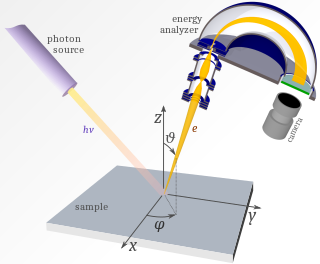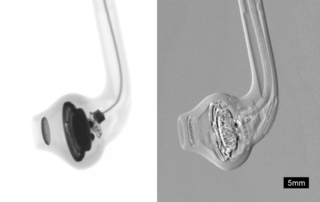Related Research Articles

The photoelectric effect is the emission of electrons when electromagnetic radiation, such as light, hits a material. Electrons emitted in this manner are called photoelectrons. The phenomenon is studied in condensed matter physics, and solid state and quantum chemistry to draw inferences about the properties of atoms, molecules and solids. The effect has found use in electronic devices specialized for light detection and precisely timed electron emission.

Synchrotron radiation is the electromagnetic radiation emitted when relativistic charged particles are subject to an acceleration perpendicular to their velocity. It is produced artificially in some types of particle accelerators, or naturally by fast electrons moving through magnetic fields. The radiation produced in this way has a characteristic polarization and the frequencies generated can range over a large portion of the electromagnetic spectrum.

A radio galaxy is a galaxy with giant regions of radio emission extending well beyond its visible structure. These energetic radio lobes are powered by jets from its active galactic nucleus. They have luminosities up to 1039 W at radio wavelengths between 10 MHz and 100 GHz. The radio emission is due to the synchrotron process. The observed structure in radio emission is determined by the interaction between twin jets and the external medium, modified by the effects of relativistic beaming. The host galaxies are almost exclusively large elliptical galaxies. Radio-loud active galaxies can be detected at large distances, making them valuable tools for observational cosmology. Recently, much work has been done on the effects of these objects on the intergalactic medium, particularly in galaxy groups and clusters.
The volcanic winter of 536 was the most severe and protracted episode of climatic cooling in the Northern Hemisphere in the last 2,000 years. The volcanic winter was caused by at least three simultaneous eruptions of uncertain origin, with several possible locations proposed in various continents. Most contemporary accounts of the volcanic winter are from authors in Constantinople, the capital of the Eastern Roman Empire, although the impact of the cooler temperatures extended beyond Europe. Modern scholarship has determined that in early AD 536, an eruption ejected massive amounts of sulfate aerosols into the atmosphere, which reduced the solar radiation reaching the Earth's surface and cooled the atmosphere for several years. In March 536, Constantinople began experiencing darkened skies and cooler temperatures.

A synchrotron light source is a source of electromagnetic radiation (EM) usually produced by a storage ring, for scientific and technical purposes. First observed in synchrotrons, synchrotron light is now produced by storage rings and other specialized particle accelerators, typically accelerating electrons. Once the high-energy electron beam has been generated, it is directed into auxiliary components such as bending magnets and insertion devices in storage rings and free electron lasers. These supply the strong magnetic fields perpendicular to the beam which are needed to convert high energy electrons into photons.

Photoemission spectroscopy (PES), also known as photoelectron spectroscopy, refers to energy measurement of electrons emitted from solids, gases or liquids by the photoelectric effect, in order to determine the binding energies of electrons in the substance. The term refers to various techniques, depending on whether the ionization energy is provided by X-ray, XUV or UV photons. Regardless of the incident photon beam, however, all photoelectron spectroscopy revolves around the general theme of surface analysis by measuring the ejected electrons.

The Sombrero Galaxy is a peculiar galaxy of unclear classification in the constellation borders of Virgo and Corvus, being about 9.55 megaparsecs from the Milky Way galaxy. It is a member of the Virgo II Groups, a series of galaxies and galaxy clusters strung out from the southern edge of the Virgo Supercluster. It has a diameter of approximately 15 kiloparsecs, three-tenths the size of the Milky Way.

An X-ray microscope uses electromagnetic radiation in the X-ray band to produce magnified images of objects. Since X-rays penetrate most objects, there is no need to specially prepare them for X-ray microscopy observations.

A free-electron laser (FEL) is a light source producing extremely brilliant and short pulses of radiation. An FEL functions and behaves in many ways like a laser, but instead of using stimulated emission from atomic or molecular excitations, it employs relativistic electrons as a gain medium. Radiation is generated by a bunch of electrons passing through a magnetic structure. In an FEL, this radiation is further amplified as the radiation re-interacts with the electron bunch such that the electrons start to emit coherently, thus allowing an exponential increase in overall radiation intensity.

The Canadian Light Source (CLS) is Canada's national synchrotron light source facility, located on the grounds of the University of Saskatchewan in Saskatoon, Saskatchewan, Canada. The CLS has a third-generation 2.9 GeV storage ring, and the building occupies a footprint the size of a Canadian football field. It opened in 2004 after a 30-year campaign by the Canadian scientific community to establish a synchrotron radiation facility in Canada. It has expanded both its complement of beamlines and its building in two phases since opening. As a national synchrotron facility with over 1000 individual users, it hosts scientists from all regions of Canada and around 20 other countries. Research at the CLS has ranged from viruses to superconductors to dinosaurs, and it has also been noted for its industrial science and its high school education programs.

GRB 970228 was the first gamma-ray burst (GRB) for which an afterglow was observed. It was detected on 28 February 1997 at 02:58 UTC. Since 1993, physicists had predicted GRBs to be followed by a lower-energy afterglow, but until this event, GRBs had only been observed in highly luminous bursts of high-energy gamma rays ; this resulted in large positional uncertainties which left their nature very unclear.

The Synchrotron Radiation Center (SRC), located in Stoughton, Wisconsin and operated by the University of Wisconsin–Madison, was a national synchrotron light source research facility, operating the Aladdin storage ring. From 1968 to 1987 SRC was the home of Tantalus, the first storage ring dedicated to the production of synchrotron radiation.

A particle accelerator is a machine that uses electromagnetic fields to propel charged particles to very high speeds and energies, and to contain them in well-defined beams.

A terahertz metamaterial is a class of composite metamaterials designed to interact at terahertz (THz) frequencies. The terahertz frequency range used in materials research is usually defined as 0.1 to 10 THz.
Photoelectron photoion coincidence spectroscopy (PEPICO) is a combination of photoionization mass spectrometry and photoelectron spectroscopy. It is largely based on the photoelectric effect. Free molecules from a gas-phase sample are ionized by incident vacuum ultraviolet (VUV) radiation. In the ensuing photoionization, a cation and a photoelectron are formed for each sample molecule. The mass of the photoion is determined by time-of-flight mass spectrometry, whereas, in current setups, photoelectrons are typically detected by velocity map imaging. Electron times-of-flight are three orders of magnitude smaller than those of ions, which allows electron detection to be used as a time stamp for the ionization event, starting the clock for the ion time-of-flight analysis. In contrast with pulsed experiments, such as REMPI, in which the light pulse must act as the time stamp, this allows to use continuous light sources, e.g. a discharge lamp or a synchrotron light source. No more than several ion–electron pairs are present simultaneously in the instrument, and the electron–ion pairs belonging to a single photoionization event can be identified and detected in delayed coincidence.

Phase-contrast X-ray imaging or phase-sensitive X-ray imaging is a general term for different technical methods that use information concerning changes in the phase of an X-ray beam that passes through an object in order to create its images. Standard X-ray imaging techniques like radiography or computed tomography (CT) rely on a decrease of the X-ray beam's intensity (attenuation) when traversing the sample, which can be measured directly with the assistance of an X-ray detector. However, in phase contrast X-ray imaging, the beam's phase shift caused by the sample is not measured directly, but is transformed into variations in intensity, which then can be recorded by the detector.

AP Librae is a BL Lacertae object located at a distance of 700 million light years in the southern constellation of Libra. In the visual band it is one of the most active blazars known. AP Lib is surrounded by an extended source with a spectrum characteristic of a red-shifted giant elliptical galaxy. The derived visual magnitude of this region is 15.0, and it follows a radially decreasing brightness that is characteristic of an elliptical. Seven fainter galaxies are visible within an angular radius of 9′, suggesting it is the brightest member of a galactic cluster.
John Paul Blewett was a Canadian-American physicist, known as "a key figure in the development of particle accelerators".

Maria C. Asensio is a Spanish-Argentinian physical chemist, academic, researcher, and author. She is a Full Research Professor at the Materials Science Institute of Madrid (ICMM) of the Spanish National Research Council (CSIC) and Chair of the CSIC Research Associated Unit-MATINÉE created between the ICMM and the Institute of Materials Science (ICMUV) of the Valencia University.
References
- Moser, H. O.; B. D. F. Casse; O. Wilhelmi; B. T. Saw (2005). "Terahertz Response of a Microfabricated Rod–Split-Ring-Resonator Electromagnetic Metamaterial" (PDF). Physical Review Letters. 94 (6): 063901. Bibcode:2005PhRvL..94f3901M. doi:10.1103/PhysRevLett.94.063901. PMID 15783730.
- Moser, Herbert O. (2009). "Singapore Synchrotron Light Source". Synchrotron Radiation News. 22 (4): 23–28. Bibcode:2009SRNew..22...23M. doi:10.1080/08940880903113927. S2CID 122037011.
- Moser, H.O.; E.P. Chew; V.C. Kempson; J.R. Kong; Z.W. Li; Tun Nyunt; H.J. Qian; R. Rossmanith; P.H. Tor; O. Wilhelmi; P. Yang; H.W. Zheng; I.J. Underhay (January 2003). "Singapore Synchrotron Light Source – Status, first results, program". Nuclear Instruments and Methods in Physics Research Section B: Beam Interactions with Materials and Atoms. 199: 536–540. Bibcode:2003NIMPB.199..536M. doi:10.1016/S0168-583X(02)01596-3.